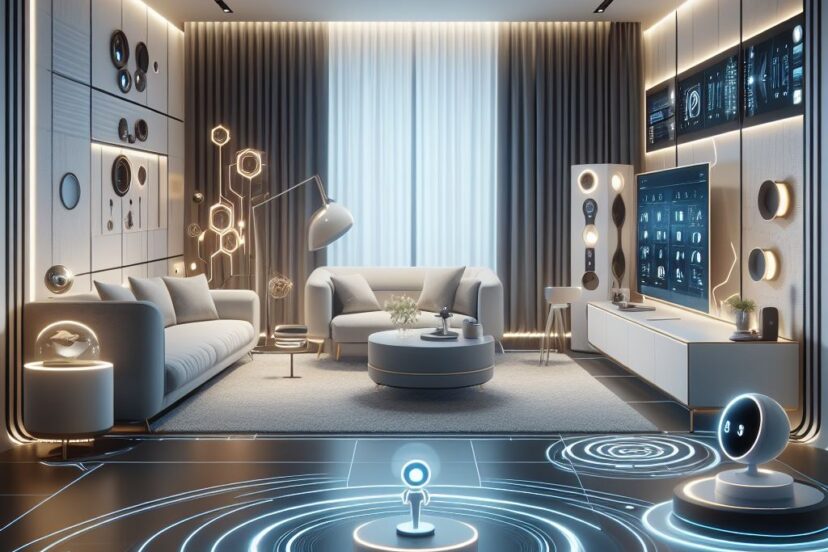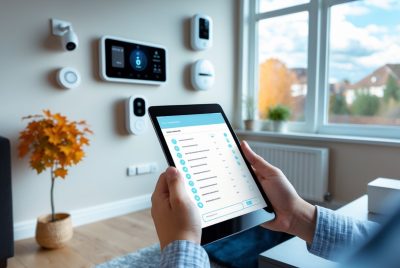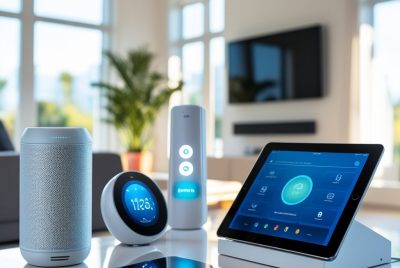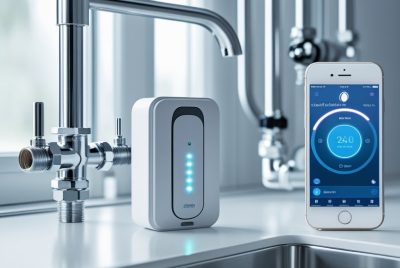Home Automation Ideas to Elevate Your Living Space Efficiency
*We may earn a commission for purchases made using our links. Please see our disclosure to learn more.
Home Automation Ideas to Elevate Your Living Space Efficiency
Home automation represents a significant shift in how I approach everyday living. Through the integration of smart devices in my home environment, I experience enhanced convenience, efficiency, and comfort. The concept extends far beyond simple gadgets, evolving into a comprehensive ecosystem that simplifies and refines my daily routines. With the right home automation ideas, I can create a living space that not only responds to my needs but anticipates them, allowing me to control various aspects of my home remotely or through voice commands.

I’ve noticed that the key to successful home automation is not just in the selection of individual smart devices but in how they are configured to work together cohesively. From smart lights that adjust to my schedule, to thermostats that regulate temperature for optimal energy use, and security systems that offer peace of mind, the possibilities are vast. The strategic implementation of these devices ensures a seamless, automated experience that can revolutionize how I interact with my home.
The integration of automated solutions is not only about convenience but also about creating a more efficient and sustainable home. Smart plugs, for example, help me manage power usage, while intelligent sensors and cameras provide me with real-time information about my home environment. By embracing home automation, I can tailor my living space to my preferences, ensuring that each aspect of my home is perfectly aligned with my lifestyle.
Fundamentals of Home Automation

In this section, I’ll cover the essential elements that constitute the core of smart home automation, guiding you through systems, device selection, and integration for an efficient smart home setup.
Understanding Home Automation Systems
Home automation systems are the digital backbone of a smart home, enabling users to manage and monitor a variety of devices remotely or through automated rules. At its base, a smart home platform acts as a central point of command and can be controlled through a mobile app or voice commands. For instance, security cameras can be programmed to send alerts to your phone or a smart lock may unlock with your phone’s proximity.
Choosing the Right Smart Home Device
When selecting a smart home device, it’s critical to consider compatibility with existing systems and whether it fulfills a specific need within your home. Devices should enhance convenience and security. For example, a smart door lock that allows remote monitoring and control can be a great addition to your home’s security.
Integrating Different Devices and Platforms
To successfully integrate varying smart home devices and platforms, look for devices that can communicate under a common protocol or are supported by a unifying smart home platform like Amazon Alexa, Google Home, or Apple HomeKit. Synchronization ensures that actions such as turning on the lights or adjusting the thermostat can be done smoothly and even simultaneously, through either automated settings or a central app.
Home Automation Ideas: Smart Control and Security
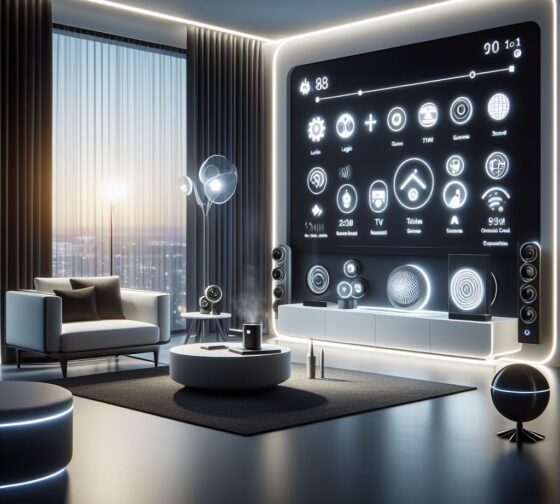
In this age of smart technology, enhancing home security is about integrating sophisticated systems that work together for a more secure and convenient living environment. I’ll discuss the integration of advanced security systems, smart access control, and strategic surveillance tactics that combine high-tech with safety.
Advanced Security Systems and Cameras
Security Systems: I recommend opting for security systems that combine high-definition cameras with motion sensors for complete coverage. These systems often allow you to monitor your home remotely via a smartphone app. Look for security cameras with features like night vision capabilities and motion-triggered alerts to stay vigilant around the clock.
Cameras: Ideally, they should be strategically placed at all entry points and vulnerable spots around your home. Some cutting-edge cameras even offer facial recognition, which adds another layer of security.
Secure Access with Smart Locks and Doorbells
Smart Locks: For keeping homes secure, I find installing smart locks to be highly effective. They enable remote locking and unlocking, often feature keypad or biometric entry options, and can alert you of any unauthorized access attempts.
Smart Doorbells: Integrating smart doorbells with video functionality can also deter potential intruders and allow you to communicate with visitors from anywhere. Plus, they can be synced with smart locks for a cohesive security experience.
Smart Alarms and Surveillance Strategies
Alarms: A robust security system includes advanced alarm systems that can detect break-ins or environmental hazards such as smoke or carbon monoxide. These alarms should connect seamlessly with other smart devices and alert you immediately in case of an incident.
Surveillance Strategies: Effective surveillance goes beyond installing cameras. It involves setting up smart sensors at windows and gates, which can trigger alarms or notify you of unexpected motion. Use automation to simulate presence at home, like setting up lights to turn on and off at various times, to deter potential burglaries.
By embracing these smart control and security home automation ideas, I’ve been able to significantly boost my home’s defense, ensuring safety with the convenience and efficiency of the latest technology.
Home Automation Ideas with Climate Control and Energy Efficiency

In this section, I’ll explore how integrating smart thermostats and optimizing HVAC systems can significantly enhance energy efficiency while maintaining comfortable temperature levels within your home.
Managing Temperature with Smart Thermostats
Smart thermostats like the Nest Learning Thermostat are instrumental in maintaining ideal temperature settings. By learning my daily routine, they adjust heating and cooling to fit my schedule. I’ve noticed that smart thermostats can reduce energy consumption by adapting to my presence, avoiding unnecessary heating or cooling when I’m not around. Additionally, I can control them remotely via smartphone apps, allowing for temperature adjustments from anywhere, ensuring my home is comfortable when I arrive.
- Key features of smart thermostats include:
- Remote access through mobile devices
- Learning capabilities to adapt to user patterns
- Energy consumption tracking and reporting
Optimizing HVAC Systems for Comfort and Savings
Enhancing HVAC efficiency is not only about the thermostat; it’s also about maintaining the system. Replacing HVAC filters regularly ensures my system runs optimally, preventing the extra energy costs associated with clogged filters. Programmable thermostats can automatically adjust settings for peak and off-peak hours, leading to considerable savings.
- To optimize HVAC systems, I follow these practices:
- Schedule regular maintenance checks
- Replace filters periodically to prevent airflow blockages
- Leverage smart technology to program heating and cooling cycles
By combining both smart thermostats and regular HVAC maintenance, I’ve seen a marked improvement—not just in energy efficiency, but also in the overall comfort of my living environment.
Home Automation Ideas for Lighting, Entertainment, and Appliances

In integrating home automation systems, I often begin with enhancements to lighting, entertainment, and appliances. These components have a significant impact on energy efficiency, convenience, and even security.
Innovative Lighting Solutions for Efficiency
I find that smart lighting systems are among the most impactful changes one can introduce to a home. They not only save energy but also offer a remarkable level of control. For instance:
- Philips Hue: A vast range of smart light bulbs and fixtures providing customizable color and brightness settings, controllable via an app.
- LIFX: Offers similar benefits as Philips Hue, with the added advantage of not requiring a hub.
Both can be scheduled for routines or triggered by events, such as sunset or movement. Smart switches and smart plugs also play a role in lighting control, allowing for traditional lamps to be integrated into home automation.
Automating Entertainment Systems and Devices
Enhancing my home with automated entertainment systems not only boosts leisure time but can contribute to home security. My typical recommendations include:
- Smart TVs: Connect to the internet and enable streaming services, often controllable via voice commands.
- Home Assistant: An open-source hub that integrates various entertainment devices for streamlined control.
Adding smart blinds to the setup allows for automatic adjustments for optimal viewing conditions, while outdoor lights and landscape lighting can enhance aesthetic appeal and security simultaneously.
Smart Appliances for a Connected Home
In the realm of appliances, automation introduces significant convenience and efficiency. Some common smart appliances include:
- Ovens: Programmable start times and temperature settings.
- Washing machines: Features like remote start and scheduling, and progress tracking through apps.
- Coffee makers: Scheduled brewing or start via voice control.
Other innovative additions are smart refrigerators that track expiration dates and robot vacuums like the Roomba, which clean the home autonomously. With smart plugs, even basic appliances can gain remote control functionality.
Automation Integration and Advanced Features

Integrating advanced features such as voice assistants and custom automation rules can significantly enhance the functionality and convenience of smart home systems. By leveraging voice commands and geofencing, I can create seamless interaction and control over my automated devices.
Voice Assistants and Multifunctional Commands
The incorporation of voice assistants like Amazon Alexa or Google Home into my home automation setup allows me to execute multifunctional commands with ease. For instance, with a simple “Good morning” command, I can program my system to gradually increase the brightness of my Eufy lights, adjust the thermostat, and even start brewing coffee with a smart plug. To illustrate the integral role these assistants play, here’s a quick breakdown:
- Timers and Reminders: Set a timer for tasks or get reminded about important events through voice prompts.
- Voice Command Customization: Personalize voice commands for specific actions, such as locking August smart locks or checking water sensor readouts.
- Device Synchronization: Control multiple devices like the Harmony Hub for entertainment settings or Kasa smart plugs for appliance management, all with a single voice command.
Custom Automation with IFTTT and Geofencing
With IFTTT (If This Then That), I can create conditional statements, known as applets, that link my smart home devices to my smartphone, enabling automation based on various triggers. For me, this involves turning on lights when I’m near home using geofencing, and automatically generating access codes for my August lock when detecting a guest’s smartphone.
Geofencing is particularly useful as it uses my smartphone’s location to trigger actions when I enter or exit a predefined geographical area, termed a geofence. Here’s how I leverage these technologies:
- Automation via Geofence:
- Enter geofence: Unlocks my door and turns on the entryway lights.
- Exit geofence: Arms my security system and lowers the thermostat.
- IFTTT Applets:
- Link to devices: Connect IKEA smart blinds to open with morning alarms.
- Location-based commands: Adjust settings on smart devices when I’m approaching or leaving specific locations.
I can tailor my home automation to fit my lifestyle and preferences using these advanced features, ensuring comfort and efficiency are always maximized.
Frequently Asked Questions
In this section, I cover several common queries about home automation, providing insights on integrating smart controllers, DIY automation projects, top device choices, starter steps for beginners, Arduino platform use, and voice assistant innovations.
1. How can I integrate smart controllers to manage home automation systems?
I can use smart controllers by connecting them through a centralized home automation hub or via wireless protocols such as Wi-Fi, Zigbee, or Z-Wave. These controllers allow me to manage multiple devices from a single interface, often accessible through a smartphone app.
2. What are some practical DIY projects for automating my home?
Practical DIY home automation projects include setting up smart lighting systems, installing smart thermostats, or creating motion sensor systems for security. I can also automate my blinds or curtains to open and close based on sunlight.
3. Which devices are considered top choices for enhancing home automation?
Top devices for enhancing home automation typically include smart thermostats, smart locks, video doorbells, and smart lighting solutions. These devices not only provide convenience but can also improve energy efficiency and security.
4. What are some basic steps to start with home automation for beginners?
For beginners, simple starting points include setting up a smart speaker, installing smart light bulbs, or incorporating smart plugs to control non-smart appliances. These initial steps can familiarize me with how home automation works before moving on to more complex setups.
5. What innovative solutions can voice assistants offer in home automation?
Voice assistants integrate with home automation for hands-free device control, routine setting, and complex tasks like starting vacuums or ovens.

